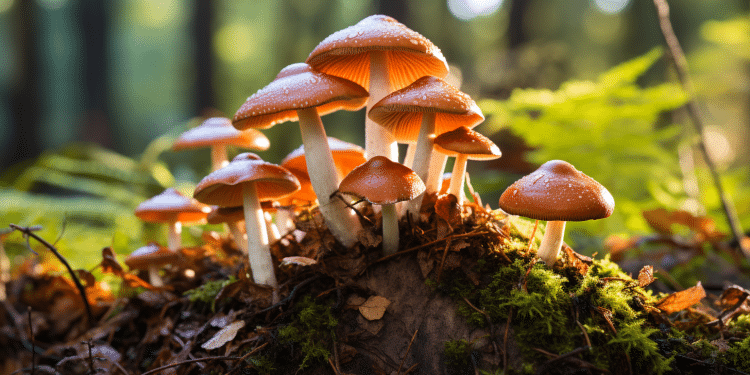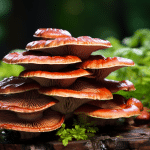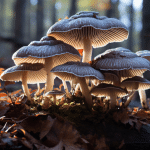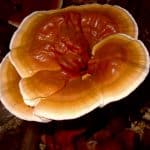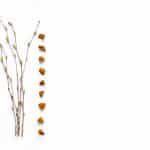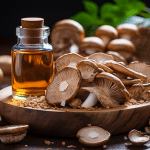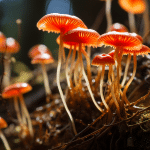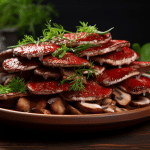As more and more people are learning the awesome health benefits of including mushrooms in their diet, there is an increasing trend for the wide variety of edible, gourmet mushrooms. One such foodie species is the kingnut mushroom (Pholiota adiposa), which has been eaten and enjoyed in Japan for centuries, yet is still relatively unknown in the Western world. The chestnut mushrooms beautiful colors, gentle flavors, and great texture are popular, with farmers growing them today throughout Japan, Asia, Europe, Australia, and North America. In this article, you will learn what is chestnut mushrooms, what their tastes are, where they are grown, how to grow them yourself, and how to prepare and cook them using tasty recipes.
What Are Chestnut Mushrooms?
Chestnut mushrooms (Pholiota adiposa), also called cap-and-fat-flavoring phaliota, are known in Japan as Numerisugitake mushrooms. They are saprotrophic, sometimes parasitic mushrooms, growing in thick clusters in decaying wood in the wild. These mushrooms are not to be confused with a darker variant of the more familiar brown, button, or cremini mushrooms (Agaricus bisporus), which are sometimes sold as chestnut mushrooms due to their shape and color.
The scientific name chestnut mushrooms gives a clue as to their appearance. “Pholiota” is a Latin word meaning scaley, while “adiposa” comes from the Latin “adeps,” meaning fat or fat-like.
The caps of chestnut mushrooms are covered in brownish-brown scales, and, in the younger stages, with floppy, white wispy bits, and they are usually slightly hirsute. And while chestnut mushrooms caps may be slimy on the outside when wet, they are only a little oily when dry. Here are a few characteristics to watch for that will assure you are dealing with Pholiota adiposa chestnut mushrooms, and not slightly darker Cremini mushrooms.
Caps — Convex, brownish-yellow to russet-orange caps that range from 2 to 4 inches (5 to 10 cm) across, with brownish-brown scales densely packed toward the center.
Young chestnut mushrooms have floppy, white lace-like segments attached to the scales.
Gills — pale yellow to tan, gills that become rusty-brown or orange when the spores are produced.
Stems – Round, pale yellow to tan stalks, 0.2 to 0.4 inches (5 to 10 mm) diameter, 1 to 2.5 inches (2.5 to 6 cm) high, with scales often joined at base, where they are attached to a substrate.
Are Chestnut Mushrooms Edible?
Yes, you can eat them, and although it might be a novelty for you, Japanese people have enjoyed it for its flavor, texture, and health benefits for centuries. Below, we provide you with a few simple, delicious recipes using chestnut mushrooms that you will want to give a try.
Is There A Difference Between Chestnut Mushrooms and Normal Mushrooms?
Chestnut mushrooms are unique in that when cooked properly, both caps and stems retain their nice, tough texture. While common mushrooms such as white, brown, button, or cremini mushrooms get mushy when cooked, they may even get limp and soggy when they are not cooked correctly.
Chestnut mushrooms have long, crunchy stalks that are far longer than those of cremini or button mushrooms, and the whole mushroom, including the stalk, is edible. You can grow chestnut mushrooms on tree trunks and in indoors in fruiting blocks made of hardwood wood chips, as opposed to Portabella, Cremini, or button mushrooms, which grow in composted manure.
Are Brown Mushrooms and Chestnut Mushrooms The Same?
No, the brown mushroom is different from the chestnut species called the Pholiota adiposa, the chestnut mushroom, which can be easily distinguished from each other due to the fact that they have distinctly different stems. But sometimes mushroom farmers will sell the usual brown mushrooms, or cremini mushrooms, as chestnut mushrooms.
So, if you find some chestnut mushrooms at a shop that look very much like your average button mushrooms, it is likely to be an Agaricus bisporus, which is the same family of mushrooms that are brown or cremini.
What Do Chestnut Mushrooms Taste Like?
Chestnut mushrooms have similar flavors to Shiitake mushrooms, however they are mellower, and have that distinctive, walnuty umami taste that gives them their name. Their slight, earthy flavors are finished off slightly spicy, and people often describe them as buttery and nutty. But it is their crisp texture, gorgeous colors, and long, edible stalks that give mushroom dishes new dimensions. They are often why people decide to prepare chestnut mushrooms.
Where Do Chestnut Mushrooms Grow in Nature?
You will frequently find wild hickory mushrooms growing in small groups, at the bottom of beech trees, dead or dying logs, stumps, and big fallen branches. But although commonly found on beech, they may also occur on cottonwood, oak, and other broadleaf hardwoods. Interestingly, chestnut mushrooms can grow on living trees and dead ones, since they are saprotrophic as well as parasitic, but tend to do best on dead, decomposing wood. They are found in the wild in Northern and Central Europe, and sometimes across the UK and Ireland, in autumn, winter, and early spring.
Are There Mushrooms Similar to Chestnut Mushrooms?
Yes, and here are some examples that are similar.
The shaggy scalycap (pholiota squarrosa) is found throughout North America, Canada, and Europe, growing on a wide variety of hardwoods and conifers. It is typically pale, with much larger caps and stem scales than chestnut mushrooms.
Depending on its source, shaggy cap odor is said to resemble garlic, turnips, skunks, or onions, and it tastes strongly like turnips. Although reported by some to be edible, it may be toxic when consumed with alcohol.
The alder scallycap (pholiota alnicola) is typically found on the dead and dying trunks of alders, but it may also occur on other hardwoods and sometimes in conifers.
It occurs all over North America, Northern and Central Europe, and Asia, and unlike the chestnut mushrooms, the alder scalycap does not have any scales on the caps.
The dark honey fungus (Armillaria mellea) has scales, and grows in clusters like chestnut mushrooms. But the stalks of dark honey fungus are darker, with many more scales, compared to the chestnut mushrooms, which has some scaling near the base of the stalk. Another difference is that the dark honey fungus has white spores, meaning their gills will not get darker when mature.
The sheathed woodtuft (kuehneromyces mutabilis) also known as the brown stew fungus, this beautiful edible mushroom grows all over Britain, Ireland, Europe, Asia, Australia, and North America.
Sheathed woodtuft mushrooms can look a lot like chestnut mushrooms, though their caps are often two-toned and vary in colour. When wet, they are cinnamon-orange, but they dry down to a much lighter, tan. The biggest difference is in their stems, where there is a distinct ring with much darker colors underneath.
The funeral bell mushroom (galerina autumnalis), is look-alike that you should avoid at all costs. The name says it all, these mushrooms are deadly, and they have the same toxin in them that deathcap mushrooms (Amanita phalloides) do. Like the chestnut mushrooms, they grow in clusters and have a sticky, brown cap, with yellow-to-rusty colored gills, but the notable difference is they do not have any scales on the caps.
Nutritional Profile of Chestnut Mushrooms
Like most other edible mushrooms, chestnut mushrooms are packed with essential amino acids, vitamins, minerals, and protein. This food composition database has an in-depth breakdown of all of the amino acids, minerals and vitamins found in 100g servings of the chestnut mushroom, known as Numerisugitake in Japan.
Chestnut mushrooms are not only a good source of protein and other nutrients, they have antimicrobial and tumor-fighting properties, and they contain lectins which may help to prevent certain tumor cells from spreading. They also contain anti-inflammatory and antioxidative compounds, which aid in treating inflammation and boosts your immune system.
